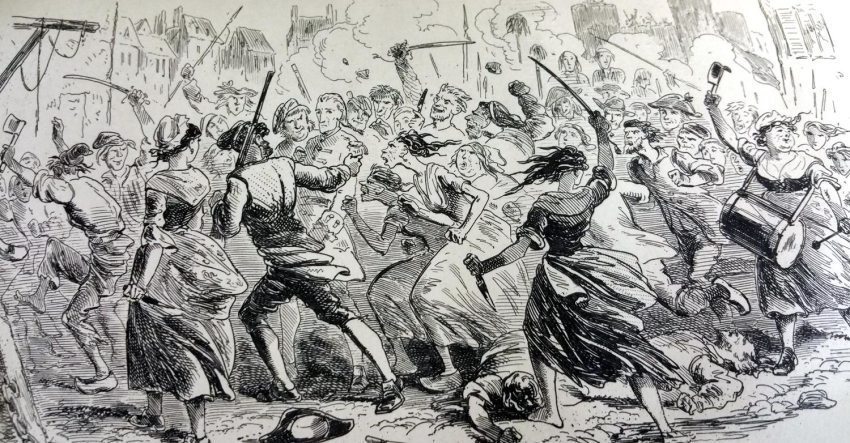July 9, 2018
Image from First Edition, A Tale of Two Cities, Charles Dickens, 1860
“It was the best of times, it was the worst of times, it was the age of wisdom, it was the age of foolishness, it was the epoch of belief, it was the epoch of incredulity, it was the season of Light, it was the season of Darkness, it was the spring of hope, it was the winter of despair, we had everything before us, we had nothing before us, we were all going direct to Heaven, we were all going direct the other way – in short, the period was so far like the present period, that some of its noisiest authorities insisted on its being received, for good or for evil, in the superlative degree of comparison only.”
The famous opening line of A Tale of Two Cities could easily apply to the various evaluations, outlooks, and prescriptions for the U.S. Postal Service in 2018.
We have said before, and will say again, that much of the “season of Darkness” talk about USPS has been greatly exaggerated in order to pursue one’s goals. Whether your goal is relief from future obligations, pricing freedom, saving the Postal Service balance sheet, or dismantling and complete privatization, the “winter of despair” narrative has been your go-to storyline. Others who embrace the “spring of hope” and much prefer the status quo have argued that minor tweaks to retiree benefits will suffice.
As with most important matters, the truth lies somewhere between the extremes. There are at least three variations of two-step prescriptions that we describe below. We believe the first two were prompted by overly negative, pessimistic descriptions of the state of our postal system. The third is our recommendation.
Two-Step Proposal #1–USPS
Step 1—Pass legislation contained in the House (H.R. 6076) and Senate (S. 2629) bills.
Step 2—Implement the Postal Regulatory Commission proposal in the ten-year regulatory review or, better yet, remove the CPI cap completely. (RM2017-3).
This proposal is very familiar to all postal-watchers, as it is the one that has been pushed by postal management and labor for some time. We have expressed three main reservations about it, primarily in our hundreds of pages of comments and analysis in the PRC case:
- It does very little to address the need for better operational cost-control and productivity growth.
- It decimates the incentives for postal management and labor to increase efficiency and competitiveness.
- It contains major postage rate increases (2.15% one time in the bills, plus 5% to 7% per year for five years compounding to 28% to 40% in the PRC proposal) that would push many customers and much mail volume out of the system.
A variation on Proposal #1, let’s call it #1B, is that of the Coalition for a 21st Century Postal Service, who agrees with Step 1, but whose second step is “considering whether and what business model or other changes would have to be made to sustain USPS in the long-term.”
Proposal #1B seems to kick the can down the road and expose all mailers to the clear and present danger of the PRC regulatory review.
Two-Step Proposal #2–Administration
Step 1—Implement major reforms that bring the USPS to sustainable profitability to enable full privatization.
Step 2—Following the model of European posts, sell the USPS to the private sector and ensure universal service through government regulation similar to that of utilities.
This is the proposal of the Administration, and its major reforms will only be fleshed out with the release of the President’s Task Force on the United States Postal System (PTFUSPS) on or about August 10, 2018.
On June 21, the Trump Administration released a 132-page report titled “Delivering Government Solutions in the 21st Century: Reform Plan and Reorganization Recommendations.” This set of proposals created quite a ruckus in Washington and beyond. Government Executive reported: “The Trump administration on Thursday released a blueprint for a massive overhaul of the federal bureaucracy, one that if implemented would touch virtually every agency and the way all Americans receive government services.”
Two-and-a-half of the pages dealt with the U.S. Postal Service, and they caused a stir within the postal community. Many were surprised that this report pre-empted the PTFUSPS that is scheduled for release on August 10. The hullabaloo was caused mainly by the June 21 report’s reference to a goal of “privatization” of the USPS.
The June 21 report did state clearly that privatization is not an immediate option because first USPS must return to a sustainable, profitable status. Indeed, the report allowed that conversion to a privately-held corporation is a goal, but not an inevitability.
Here is the summary of the proposal:
“This proposal would restructure the United States Postal System to return it to a sustainable business model or prepare it for future conversion from a Government agency into a privately-held corporation. Like many European nations, the United States could privatize its postal operator while maintaining strong regulatory oversight to ensure fair competition and reasonable prices for customers. The President’s Task Force on the United States Postal System will make recommendations on reforms towards this goal in August 2018.”
Not surprisingly, USPS management, labor, and the mailing industry reacted very negatively to the Administration’s proposal. It creates a great degree of uncertainty for all and sounds a lot like an ideological fix for what we participants view as a practical problem.
Ironically, though, Proposal #2 relies heavily on the very same “worst of times” narrative of the state of the USPS that the proponents of Proposal #1 have been using for the last several years. Many of the very same statistics and data that the Postal Service has been emphasizing in its official reports are cited in the Administration’s June 21 report that recommends privatization.
Two-Step Proposal #3–Alliance
Step 1—Pass the reforms of USPS retiree liabilities contained in the House and Senate bills. Leave out the unnecessary and damaging 2.15% first legislated postage increase since 1968. Include the language in the Senate bill that instructs the PRC to take into account new legislation.
Step 2—Appoint and confirm a strong USPS Board of Governors with a mandate to bring our Postal Service back to productivity growth and net incomes within the constraints of current law, especially the CPI cap on postage increases.
We believe that extreme “worst of times” rhetoric begets extreme proposals, including Proposals #1 and #2. We think the truth is somewhere in between the best and worst of times. If USPS liabilities are accurately estimated and responsibly funded, and costs are kept in line with the competitive landscape, USPS can thrive in the years to come.
While some proponents of extreme measures have argued that the CPI price increase cap is “artificial” or not something that private sector firms face, it actually is quite similar to the external constraints most businesses must deal with. In addition, it is absolutely necessary as a component of the regulation of a government-granted legal monopoly.
A new Board of Governors is the most important, effective and immediate reform that can be implemented. Even if Step 1 is delayed or fails to happen, Step 2 is what our postal system needs most right now.
The Board must direct management to deal with the cards it is dealt and return to the can-do attitude that generated recent annual positive productivity growth and operating profits. The danger of extreme proposals can and should be averted by a return to very much attainable effectiveness and efficiency. And we expect the PTFUSPS comprehensive analysis will have useful recommendations to make USPS more profitable.
But let’s not make the prescription worse than the illness.



Leave a Reply